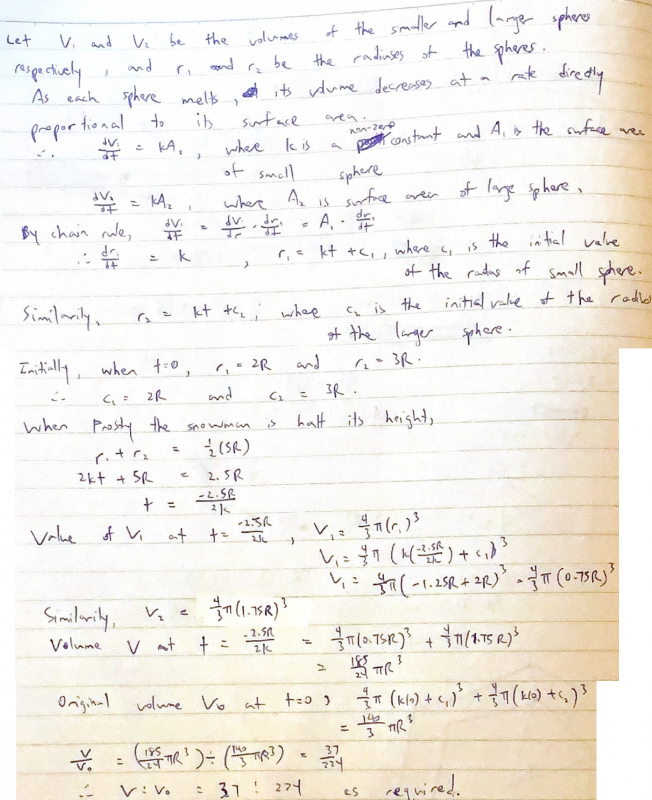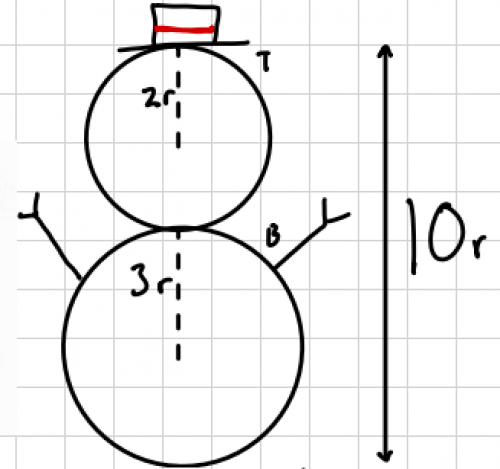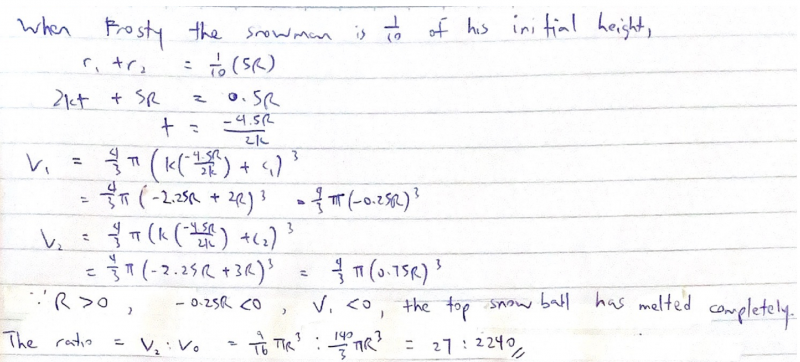Frosty the Snowman
Frosty the Snowman is melting. Can you use your knowledge of differential equations to find out how his volume changes as he shrinks?
Problem

If you are getting stuck on this question, start by reading A Guide to Problem Solving. Also try taking a break (take the dog/chicken for a walk, have some dinner, sleep on it!) and then try again.
You can also use the Getting Started tab, where you will find some hints and tips to guide you through the question.
Frosty the snowman is made from two uniform spherical snowballs, of initial radii $2R$ and $3R.$ The smaller (which is his head) stands on top of the larger.
As each snowball melts, its volume decreases at a rate which is directly proportional to its surface area, the constant of proportionality being the same for both snowballs. During melting each snowball remains spherical and uniform.
- When Frosty is half his initial height, show that the ratio of his volume to his initial volume is 37 : 224.
- What is this ratio when Frosty is one-tenth of his initial height?
Are the assumptions in this question reasonable? In what ways might the question be modified to make it more realistic?
Can you think of any other questions to ask about Frosty's plight?
Frosty the snowman appears again in A Frosty Puddle.
Adapted from STEP Mathematics I, 1991, Q2. Question reproduced by kind permission of Cambridge Assessment Group Archives. The question remains Copyright University of Cambridge Local Examinations Syndicate ("UCLES"), All rights reserved.
Getting Started
You might find the following useful!
- Surface area of a sphere: $A=4 \pi r^2$
- Volume of a sphere: $V=\frac 4 3 \pi r^3$
Can you write down a differential equation connecting $V$ and $A$, using what you have been told about the rate at which the volume decreases?
Can you rewrite the differential equation in terms of $r$?
It might be helpful to use notation like $r_1=$ radius of head, $r_2=$ radius of body.
Can you solve the differential equation to find $r_1$ and $r_2$ in terms of $t$?
Can you write the height of Frosty ($h$) as a function of $r_1$ and $r_2$? (it might help to draw a sketch of Frosty!) Can you write $h$ in terms of $t$?
What is the initial value of $h$? Can you find an expression for $t$ when the height is half the initial height?
Can you use this value of $t$ to find out the radii of the two snowballs at this time? Use this to find the volumes of each one.
What is the total volume of Frosty at the start? What is the total volume when the height is half the initial height? Can you find a simplify a ratio between these two total volumes?
At what point does Frosty's head disappear?
In terms of $R$, how tall is Frosty when his height is one tenth of the initial height? What does that tell you?
Student Solutions
Well done to the students who submitted solutions to this challenging problem: Walter from Abingdon School, and Nina and Jokubas from London Academy of Excellence Tottenham, in the UK.
Nina, Jokubas and Walter sent in solutions that involved the radii as linear functions of time, i.e. $r_1=kt_2r$ and $r_2=kt+3R$ (where $k<0$). As Jokubas argued, using S.A. to stand for surface area
$\dfrac{d}{dt}V \propto \text{S.A.}$
Therefore $\dfrac{d}{dt}V = - k \text{S.A.}$
$\dfrac{d}{dt}\left( \dfrac{3}{4} \pi r^3\right) = -k (4\pi r^2)$
Then dividing both sides by $4\pi r^2$ leads to
$\dfrac{dr}{dt}=-k$.
$\int -k dt$ (Integrating $\dfrac{dr}{dt}$ gives us a function of $r$ in terms of $t$ (and $k$).)
$\text{Radius} =-kt +C$
Which Jokubas used to obtain $R_T=-kt+2r$ and $R_B=-kt+3r$. (Note that $r$ is used here instead of the $R$ in the question for the intial radius).
(Note that including a negative sign is a common choice when you know that something is decreasing, but this means that $k$ must be positive to ensure that $-k$ is negative.)
Walter's work here shows how these were obtained using a slightly different method that used the chain rule, and goes on to give a full solution to the first part of the problem (click here to see a larger version):


You may have noticed a slight error here involving the initial height (which other students also made).
If the two snowballs initially have radii $2R$ and $3R$ then Frosty's initial height is not $5R$, as Jokubus' diagram helpfully shows here.
You might find it interesting to think about why the slight error here hasn't affected the final result.
Walter's solution to the second part of the problem is almost perfect (click here to see a larger version):

Once Walter realises that the top snowball is completely melted (and has a negative radius), Walter removes that snowball from the volume calculation - which is correct.
However, Walter should have recalculated the appropriate radius of the remaining snowball using the new information that the smaller snowball had disappeared.
What should the answer be?
At the end of the problem we asked you about what assumptions you had used and whether you think these are realistic. Nina made the following comments:
Assumption is uniform melting and constant proportionality. Real snow would melt unevenly. To be more realistic, consider varying melting rates based on temperature.
This is an interesting variation of the problem - you could think about how you might start to model varying melting rates.
Teachers' Resources
This version of the problem is almost identical to Frosty is Melting!, but here there is a rationale for why the radius decreases as it does.
There are some possible starting points in the Getting Started section.
Here are word and pdf versions of the problem.
There appear to be at least three different versions of this question!
Version 1 - original STEP question from 1991
If $V$ and $S$ denote his total volume and surface area respectively, find the maximum value of $\dfrac{\mathrm{d}V}{\mathrm{d}S}$ up to the moment when his head disappears.
Version 2 - Stephen Siklos' "Advanced problems in Mathematics" 2008 edition
Frosty the snowman is made from two uniform spherical snowballs, of radii $2R$ and $3R.$ The smaller (which is his head) stands on top of the larger. As each snowball melts, its volume decreases at a rate which is directly proportional to its surface area, the constant of proportionality being the same for both snowballs. During melting, the snowballs remain spherical and uniform. When Frosty is half his initial height, show that the ratio of his volume to his initial volume is 37 : 224.
Let $V$ and $h$ denote Frosty's total volume and height at time $t$. Show that, for $2R <h \le 10R$, $$\dfrac{\mathrm{d} V}{\mathrm{d} h}=\frac{\pi} 8 (h^2 + 4R^2)$$
and derive the corresponding expression for $0 \le h < 2R$.
Sketch $\dfrac{\mathrm{d} V}{\mathrm{d} h}$ as a function of $h$ for $4R \ge h \ge 0$. Hence give a rough sketch of $V$ as a function of $h$.
Version 3 - Stephen Siklos' "Advanced problems in Mathematics" 2015 edition, and 2019 edition
What is this ratio when Frosty is one tenth of his initial height?
This problem is one of a collection designed to develop students' carbon numeracy; we hope it will encourage students to think about the issues surrounding climate change. You can find the complete collection here.
